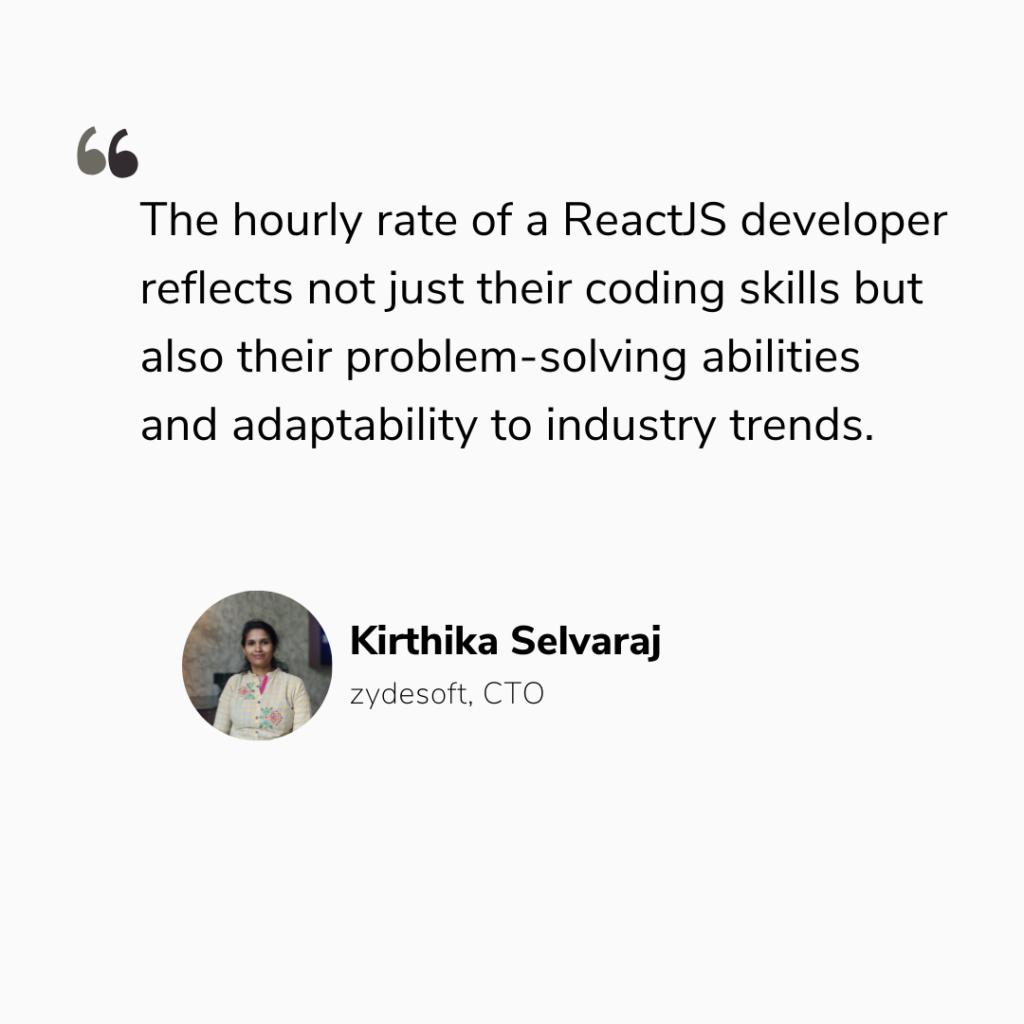
ReactJS is revolutionizing modern web development, making user interfaces more dynamic, responsive, and engaging. As businesses strive for seamless digital experiences, the demand for skilled ReactJS developers is increasing. Whether you’re a company looking to hire or a developer setting your rates, understanding the ReactJS developers hourly rate is essential.
So, how much do React developers make per hour? Well, it depends on various factors like experience, location, and project complexity.
Currently, the average hourly rate for a ReactJS developer in the United States ranges from $55 to $62, depending on experience, while senior developers typically earn between $70 and $80 per hour. Meanwhile, in India, PayScale reports that React.js developers earn an average hourly rate of ₹396.63. These figures show how location significantly impacts earnings.
In this blog, we’ll dive into the key factors that influence ReactJS developer cost, helping you make well-informed hiring or career decisions.
The ReactJS developer cost is influenced by various factors, each playing a significant role in determining how much a developer can charge for their services.
Understanding these factors will help you determine the cost of hiring a ReactJS developer and make the best decision when hiring developers for your project.

React is the most popular JavaScript library compared to Vue.js and Angular, according to a study by W3techs that analyzes millions of websites. Its widespread adoption is largely due to its user-friendliness and versatility, making it particularly suitable for developing intricate web applications.
According to ZipRecruiter, the ReactJS developers hourly rate in the US ranges from $50 to $75 depending on the level of experience. The hourly rate can vary significantly based on the geographical location of the developer, as it is directly related to factors like cost of living, demand for tech talent, and market competitiveness.
Local Demand and Supply: Hourly rates may also be influenced by the local demand-supply dynamics in specific regions. In areas where there is a scarcity of skilled ReactJS developers, rates may be driven upward as employers compete to attract talent. Conversely, in regions with an oversupply of developers, rates may be more competitive as developers vie for available projects.

The React.js developer hourly rate varies depending on the developer’s expertise with different technologies within the React ecosystem. Developers proficient in specialized tech stacks often command higher rates due to the added value they bring to projects.
| Tech Stack Proficiency | Hourly Rate ($) |
| ReactJS | $50 – $75 |
| Redux | $53 – $77 |
| GraphQL | $57- $73 |
| TypeScript | $55- $77 |
| Next.js | $50 – $70 |
| React Native | $50 – $80 |
Based on talent.com’s statistics, as of April 2024, Redux developers command an average hourly rate of $62.50, React Native developers earn approximately $60.55 per hour, and Next.js developers also earn an average of $62.50 per hour. Meanwhile, GraphQL developers typically make around $57.69 per hour, and Typescript developers command an average hourly rate of $63.70 in the United States.
React Developers proficient in different tech stacks look for higher rates due to the added value they bring to projects. These technologies are often associated with more complex or specialized projects that demand a higher level of expertise and experience. If you’re considering the cost of hiring ReactJS developers, keep in mind that those skilled in advanced frameworks and tools often charge premium rates for their expertise.
As of April 2024, the ReactJS developers hourly rate in the United States averages around $62, according to ZipRecruiter. However, this rate can vary significantly depending on factors such as experience level, location, and skill set.
Despite stiff competition from other frontend frameworks such as Vue.js and Angular, ReactJS maintains its dominance in the market. This is reflected in the consistent demand for ReactJS developers and the stability of their hourly rates over time.
Hourly rates for ReactJS developers tend to be slightly higher than those for backend developers, reflecting the frontend’s critical role in user experience and interface design. However, the perceived complexity and technical requirements of backend development can also influence hourly rates for backend technologies. In many cases, the React JS developer’s hourly rate remains competitive due to the high demand for interactive and visually appealing web applications.
While backend development requires deep technical knowledge, the demand for engaging, high-performing user interfaces keeps ReactJS developers in high demand, often commanding higher rates.
Negotiating hourly rates for React developers involves understanding market dynamics and communicating effectively. Here’s a step-by-step guide to help you navigate these discussions:

The ReactJS developers hourly rate can vary significantly depending on several factors, including their experience, location, and the need of your project. While freelance React developers might offer lower rates, they might not always provide the same level of expertise or reliability as a full-time employee or agency. It’s crucial to evaluate the pros and cons of each option based on your specific needs and budget. By understanding the factors that influence pricing, you can make a more informed decision and ensure that you’re getting the best value for your investment. Whether you choose a junior developer or a senior expert, the key is to align the developer’s skills with your project goals for optimal results.
What is the average hourly rate for ReactJS developers in 2024?
As of April 2024, the average ReactJS developer hourly rate in the United States is $62, according to ZipRecruiter. However, the rates may vary across regions based on factors such as experience level, location, and skill set.
How can I negotiate the ReactJS developers hourly rate?
When negotiating rates, consider the developer’s expertise, project requirements, and market standards. Be transparent about your budget and expectations to reach a mutually beneficial agreement, keeping in mind the React JS developer cost based on their experience and project scope.
Do ReactJS developers offer fixed-price project options?
While many ReactJS developers prefer hourly rates, some may offer fixed-price project options based on project scope and requirements. Discuss your preferences with the developer to find the best arrangement.
Are there any additional costs besides the ReactJS developers hourly rate?
In addition to the hourly rate, consider potential expenses such as project management fees, software licenses, and communication tools. Clarify these details with the developer before starting the project.
How can I ensure I’m hiring a reputable ReactJS developer?
Look for developers with a strong portfolio, positive client reviews, and relevant certifications or credentials. Conduct interviews to assess their technical skills, communication abilities, and compatibility with your project needs.